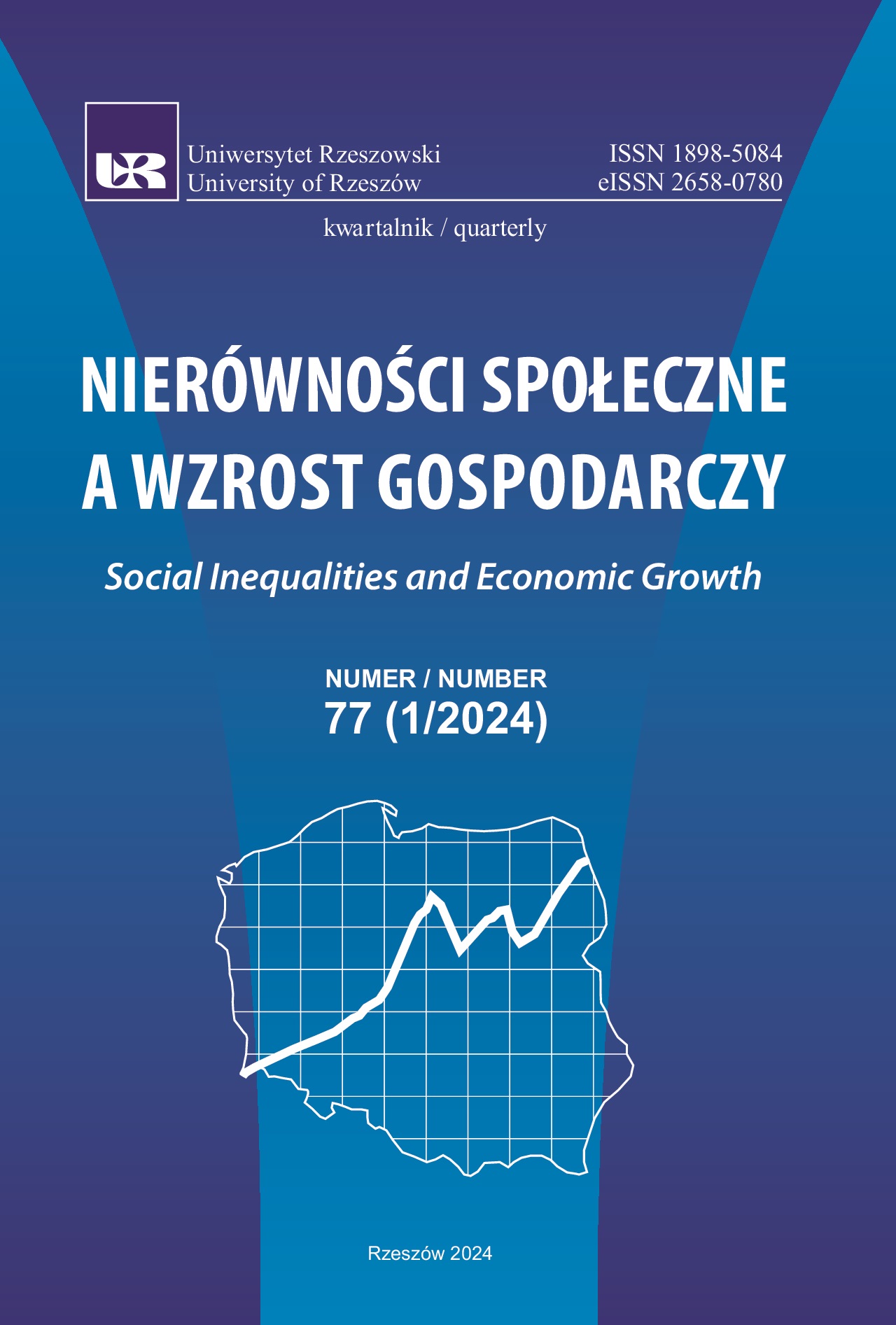Nakłady na działalność badawczo-rozwojową a pozycja innowacyjna gospodarek krajów Unii Europejskiej
DOI:
https://doi.org/10.15584/nsawg.2024.1.3Słowa kluczowe:
nakłady na działalność B+R, innowacyjność gospodarki, pozycja innowacyjna, modelowanie równań strukturalnych, PLS-SEMAbstrakt
Artykuł porusza problematykę innowacyjności krajów Unii Europejskiej. Innowacyjność gospodarki jest rozumiana jako zdolność do tworzenia i wdrażania innowacji. Cel prowadzonych badań stanowi określenie siły i kierunku wpływu nakładów na działalność B+R na pozycję innowacyjną unijnych gospodarek. Pozycja innowacyjna to jedna z dwóch kategorii opisujących innowacyjność gospodarki. Wyraża efekty połączenia kreatywności społeczeństwa z zasobami finansowymi w określonym środowisku ekonomicznym i instytucjonalnym. Z kolei nakłady na działalność B+R są istotnym czynnikiem determinującym zdolność danej gospodarki do innowacji, tj. stopnia, w jakim ma ona możliwość tworzenia i komercjalizacji nowych pomysłów. W artykule nakłady rozpatrywane są w dwóch kategoriach: kapitału finansowego i kapitału ludzkiego. Weryfikacji podlega hipoteza główna mówiąca o tym, że nakłady na działalność B+R mają dodatni, istotny statystycznie wpływ na pozycję innowacyjną gospodarki. Do realizacji celu badań oraz weryfikacji sformułowanej hipotezy zastosowano modelowanie równań strukturalnych PLS-SEM (partial least squares structural equation modeling). Modele PLS-SEM oszacowano na podstawie danych przekrojowych dotyczących 27 krajów UE. Dane odnosiły się do trzech lat: 2017, 2019 i 2021. Wyniki modelowania wskazały, że w badanym okresie nakłady na działalność B+R wywierały silny, dodatni, istotny statystycznie wpływ na pozycję innowacyjną gospodarek krajów UE. Zarówno kapitał finansowy, jak i kapitał ludzki wpływały istotnie, dodatnio na pozycję innowacyjną analizowanych gospodarek, przy czym większe znaczenie miał kapitał finansowy. W artykule dokonano również porządkowania krajów UE ze względu na wielkość nakładów na B+R, kapitał finansowy i ludzki oraz pozycję innowacyjną gospodarki.
Downloads
Bibliografia
Baum, Ch.F., Lööf, H., Nabavi, P., Stephan, A. (2017). A new approach to estimation of the R&D – innovation – productivity relationship. Economics of Innovation and New Technology, 26(1–2), 121–133. DOI: 10.1080/10438599.2016.1202515. DOI: https://doi.org/10.1080/10438599.2016.1202515
Becker, J.-M., Klein, K., Wetzels, M. (2012). Hierarchical latent variable models in PLS-SEM: guidelines for using reflective-formative type models. Long Range Planning, 45(5), 359–394. DOI: 10.1016/j.lrp.2012.10.001. DOI: https://doi.org/10.1016/j.lrp.2012.10.001
Borowiecki, R., Siuta-Tokarska, B. (2017). Problemy innowacyjności gospodarki Polski, ze szczególnym uwzględnieniem działalności badawczo-rozwojowej. Nierówności Społeczne a Wzrost Gospodarczy, 50(2), 163–176. DOI: 10.15584/nsawg.2017.2.10. DOI: https://doi.org/10.15584/nsawg.2017.2.10
Crépon, B., Duguet, E., Mairesse, J. (1998). Research and development, innovation and productivity: an econometric analysis at the firm level. Economics of Innovation and New Technology, 7(2), 115–158. DOI: 10.1080/10438599800000031. DOI: https://doi.org/10.3386/w6696
Ciborowski, R.W. (2016). Międzynarodowy transfer technologii a innowacyjność krajów Europy Środkowo-Wschodniej. Białystok: Wydawnictwo PTE.
Ciborowski, R.W., Skrodzka, I. (2020). International technology transfer and innovative changes adjustment in EU. Empirical Economics, 59(3), 1351–1371. DOI: 10.1007/ s00181-019-01683-8. DOI: https://doi.org/10.1007/s00181-019-01683-8
Danguy, J., de Rassenfosse, G., van Pottelsberghe de la Potterie, B. (2009). The R&D-patent relationship: An industry perspective. European Investment Bank Papers, 14(1), 170–195.
European Commission. (2023). European Innovation Scoreboard 2023. Luxembourg: Publications Office of the European Union. DOI: 10.2777/119961.
Fagerberg, J., Srholec, M., Verspagen, B. (2010). Innovation and Economic Development. W: B.H. Hall, N. Rosenberg (red.), Handbook of the Economics of Innovation, t. 2 (s. 833–872). Amsterdam: North-Holland. DOI: 10.1016/S0169-7218(10)02004-6. DOI: https://doi.org/10.1016/S0169-7218(10)02004-6
Freeman, C. (2002). Continental, national and sub-national innovation systems – complementarity and economic growth. Research Policy, 31(2), 191–211. DOI: 10.1016/ S0048-7333(01)00136-6. DOI: https://doi.org/10.1016/S0048-7333(01)00136-6
Gardocka-Jałowiec, A. (2012). Nakłady na działalność badawczo-rozwojową a innowacyjność polskiej gospodarki. Ekonomista, 1, 79–99.
GUS. (2022). Zeszyt metodologiczny. Działalność badawcza i rozwojowa. Szczecin/Warszawa: Urząd Statystyczny w Szczecinie.
Hair, J.F., Hult, G.T.M., Ringle, C.M., Sarstedt, M. (2022). A primer on partial least squares structural equation modelling (PLS-SEM). Thousand Oaks: Sage. DOI: https://doi.org/10.1007/978-3-030-80519-7
Hair, J.F., Risher, J.J., Sarstedt, M., Ringle, C. M. (2019). When to use and how to report the results of PLS-SEM. European Business Review, 31(1), 2–24. DOI: 10.1108/ EBR-11-2018-0203. DOI: https://doi.org/10.1108/EBR-11-2018-0203
Henseler, J., Ringle, C.M., Sarstedt, M. (2012). Using partial least squares path mode-ling in international advertising research: basic concepts and recent issues. W: S. Okazaki (red.), Handbook of research in international advertising (s. 252–276). Cheltenham: Edward Elgar. DOI: 10.4337/9781781001042.00023. DOI: https://doi.org/10.4337/9781781001042.00023
Krawczyk, M. (2014). Wydatki przedsiębiorstw na działalność badawczo-rozwojową a pomiar innowacyjności. Prace Naukowe Uniwersytetu Ekonomicznego we Wrocławiu, 326, 115–122.
Mairesse, J., Mohnen, P. (2004). The Importance of R&D for Innovation: A Reassessment Using French Survey Data. The Journal of Technology Transfer, 30, 183–197. DOI: 10.1007/s10961-004-4365-8. DOI: https://doi.org/10.1007/s10961-004-4365-8
OECD. (2006). Podręcznik Oslo. Zasady gromadzenia i interpretacji danych dotyczących innowacji, wyd. 3. Warszawa: Ministerstwo Nauki i Szkolnictwa Wyższego.
OECD. (2015). Frascati manual 2015: guidelines for collecting and reporting data on research and experimental development, The measurement of scientific, technological and innovation activities. Paris: OECD Publishing. DOI: 10.1787/9789264239012-en.
OECD. (2017). OECD Science, Technology, and Industry Scoreboard 2017: The digital transformation. Paris: OECD Publishing. DOI: 10.1787/9789264268821-en.
OECD/Eurostat. (2018). Oslo Manual 2018: guidelines for collecting, reporting and using data on innovation, 4th edition, The measurement of scientific, technological and innovation activities. Paris: OECD Publishing/Luxembourg: Eurostat. DOI: 10.1787/9789264304604-en.
Pangsy-Kania, S. (2007). Polityka innowacyjna państwa a narodowa strategia konkurencyjnego rozwoju. Gdańsk: Wydawnictwo Uniwersytetu Gdańskiego.
Penc, J. (1999). Innowacje i zmiany w firmie. Warszawa: Placet.
Poznańska, K. (2018). Działalność badawczo-rozwojowa determinantą innowacyjności przedsiębiorstw przemysłowych w Polsce. Prace Naukowe Uniwersytetu Ekonomicznego we Wrocławiu, 538, 347–358. DOI: https://doi.org/10.15611/pn.2018.538.28
Rogowski, J. (1990). Modele miękkie. Teoria i ich zastosowanie w badaniach ekonomicznych. Białystok: Wydawnictwo Filii UW w Białymstoku.
Sarstedt, M., Hair, J.F., Cheah, J.-H., Becker, J.-M., Ringle, C.M. (2019). How to specify, estimate, and validate higher-order constructs in PLS-SEM. Australian Marketing Journal, 27(3), 197–211. DOI: 10.1016/j.ausmj.2019.05.003. DOI: https://doi.org/10.1016/j.ausmj.2019.05.003
Weresa, M.A. (2012). Systemy innowacyjne we współczesnej gospodarce światowej. Warszawa: PWN.
Weresa, M.A. (2014). Polityka innowacyjna. Warszawa: PWN.
WIPO. (2023). Global Innovation Index 2023.Innovation in the face of uncertainty. Geneva: WIPO. DOI:10.34667/tind.48220.
Wold, H. (1982). Soft modeling: the basic design and some extensions. W: K.G. Jöreskog, H. Wold (red.), Systems under indirect observations: causality, structure, prediction, t. 2 (s. 1–54). Amsterdam: North-Holland.
Pobrania
Opublikowane
Jak cytować
Numer
Dział
Licencja
Prawa autorskie (c) 2024 Uniwersytet Rzeszowski

Utwór dostępny jest na licencji Creative Commons Uznanie autorstwa – Użycie niekomercyjne – Bez utworów zależnych 4.0 Międzynarodowe.


